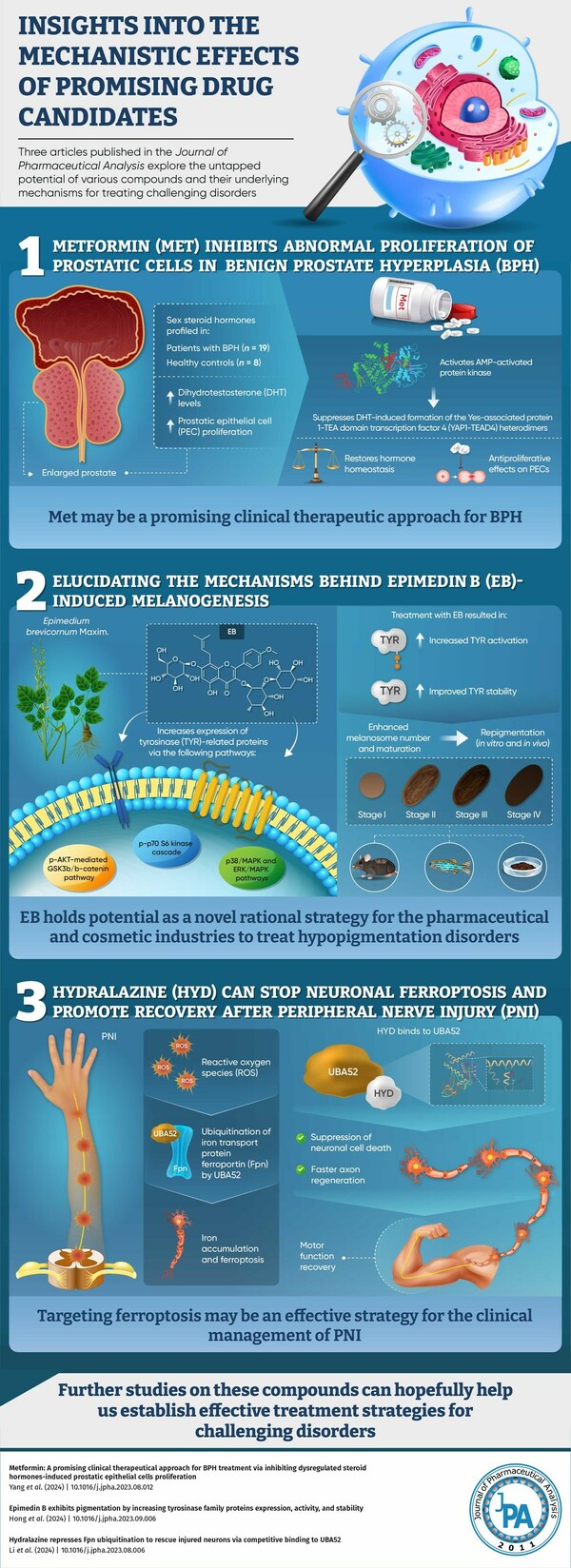Journal of Pharmaceutical Analysis (JPA) Studies Find Promising Drug Candidates
29 Mar 2024
Researchers investigate the intricacies of various cellular processes and pathologies and identify compounds with untapped therapeutic potential
XI'AN, China, March 29, 2024 /PRNewswire/ -- Understanding the underlying mechanisms of normal and pathological cellular processes is essential for developing new drugs. Fortunately, modern techniques and experimental methods have greatly accelerated progress. The latest issue of JPA features three articles in which candidate compounds for treating complex disorders were successfully identified, alongside their detailed mechanisms of action.
Continue Reading

Preview
Source: PRNewswire
Recent JPA studies identify, through detailed analyses of molecular mechanisms and cellular processes, three potential drug candidates for three different pathologies.
The first study investigated the use of metformin (Met), a drug used to manage type II diabetes, for treating benign prostate hyperplasia (BPH). The article was published in Volume 14, Issue 1 of the journal in January 2024. The researchers first sought to shed light on how and which dysregulated sex steroid hormone-related pathways shape the pathological characteristics of BPH, and whether Met can restore these pathways.
Through retrospective analysis of data from BPH patients and clinical assessment of serum and tissue samples, the researchers identified dihydrotestosterone (DHT) as a major contributor to BPH among dysregulated sex hormones. DHT promotes prostate cell proliferation by upregulating androgen receptors and forming YAP1-TEAD4 heterodimers. In vivo experiments showed that Met treatment restored sex hormone homeostasis and inhibited DHT-induced cell proliferation. "Our study provided strong evidence that Met might be a promising clinical therapeutic approach for the treatment of BPH," remark corresponding authors Prof. Qian Lu and Prof. Xiaoxing Yin.
In the second study, scientists explored the role of epimedin B (EB), the main flavonoid in the Chinese herb Epimedium brevicornum Maxim., in melanogenesis. They expanded on previous findings showing EB's ability to induce melanogenesis and activate tyrosinase family of proteins (TYRs). Through comprehensive in vitro and in vivo experiments on human and animal cells, they uncovered how EB modulated TYRs, increased melanosome numbers, promoted maturation, and aided depigmentation and repigmentation. "Our data reveals that EB can stimulate the pigmentation function of TYRs, which might provide a novel rational strategy for hypopigmentation treatment in the pharmaceutical and cosmetic industries," comments corresponding authors Dr. Yiming Li and Prof. Huali Wu.
Finally, in the third study, researchers investigated ferroptosis, a type of programmed cell death, and its role in nerve regeneration after peripheral nerve injury (PNI). They found that oxidative stress at the injury site not only triggered both apoptosis and ferroptosis in nearby neurons by increasing intracellular iron via the degradation of ferroportin by UBA52. Using the Drug Signatures Database, they identified hydralazine (HYD), a potent arterial vasodilator, as a potential UBA52 disruptor. Early HYD administration after PNI in vivo expedited axon regeneration and motor function recovery, partly by suppressing ferroptosis. "The potential clinical implementation of HYD may lead to a reduction in the prevalence of individuals with mild symptoms of nerve damage, consequently mitigating the societal burden," conclude corresponding authors Dr. Bing Xia, Prof. Zhuojing Luo, and Dr. Jinghui Huang.
Further studies will hopefully clarify the intricate connections among cellular processes, diseases, and potential drugs, paving the way for precise and efficient therapies.
Reference
Titles of original papers
Epimedin B exhibits pigmentation by increasing tyrosinase family proteins expression, activity, and stability
Hydralazine represses Fpn ubiquitination to rescue injured neurons via competitive binding to UBA52
Journal: Journal of Pharmaceutical Analysis
DOI
1. https://doi.org/10.1016/j.jpha.2023.08.012
2. https://doi.org/10.1016/j.jpha.2023.09.006
3. https://doi.org/10.1016/j.jpha.2023.08.006
Media contact
Mengjie Wang
[email protected]
+86-(0)29-88960092
SOURCE Journal of Pharmaceutical Analysis (JPA)
For more details,please visit the original website
The content of the article does not represent any opinions of Synapse and its affiliated companies. If there is any copyright infringement or error, please contact us, and we will deal with it within 24 hours.
Organizations
-Hot reports
Get started for free today!
Accelerate Strategic R&D decision making with Synapse, PatSnap’s AI-powered Connected Innovation Intelligence Platform Built for Life Sciences Professionals.
Start your data trial now!
Synapse data is also accessible to external entities via APIs or data packages. Leverages most recent intelligence information, enabling fullest potential.


